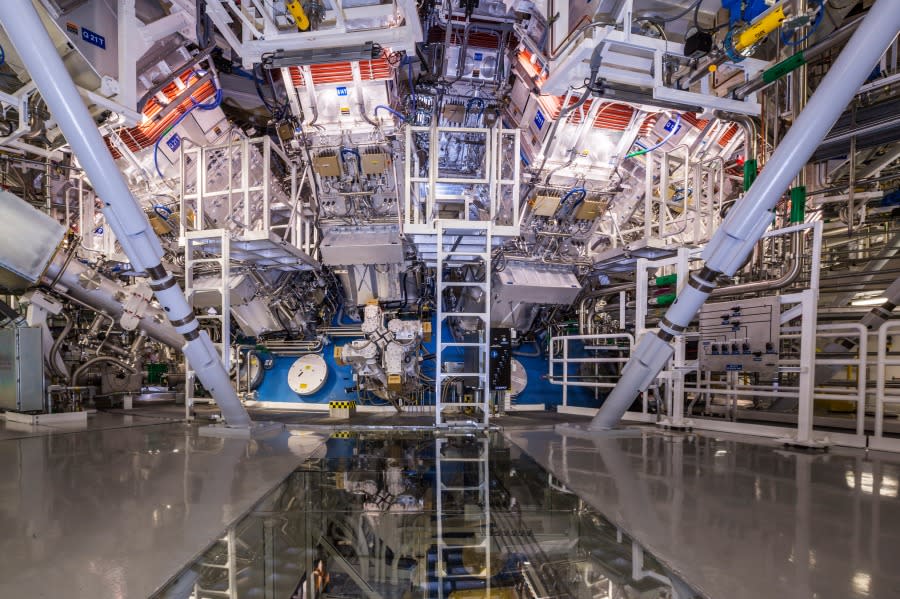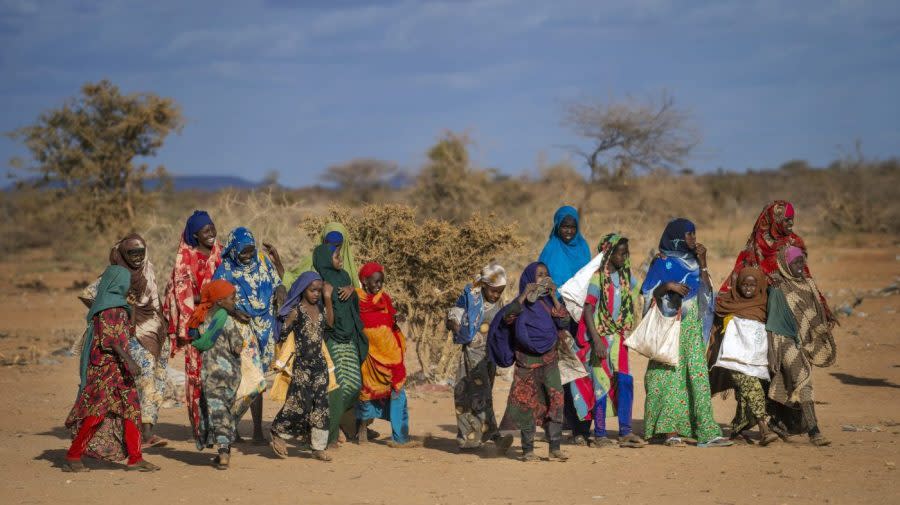Blizzards bury Plains as tornadoes head for South
- Oops!Something went wrong.Please try again later.
Blizzard conditions are expected to bury much of the Northern Plains through Wednesday, as a multiday tornado outbreak threatens the South-Central U.S.
Incoming from the West Coast: The winter storm first moved onshore this weekend in the Pacific states, drenching coastal California with rain and bringing snow to the Intermountain West, according to AccuWeather.
The system then shifted eastward on Tuesday, where “hundreds of thousands of square miles from the central Rockies through the northern Plains will be affected,” said AccuWeather meteorologist Alex Sosnowski.
Blizzard warnings abound: Blizzard warnings were in effect on Tuesday for portions of six states: western Nebraska, northeastern Colorado, western South Dakota, southeastern Montana, eastern Wyoming and far northwestern Kansas, AccuWeather reported.
It’s all connected: The same storm system is expected to generate severe weather — including tornadoes — across the southern U.S. through the middle of the week, according to AccuWeather.
The storm will progress across northeastern Texas, Louisiana, Arkansas and western Mississippi into Tuesday night.
From Wednesday morning through evening, the greatest severe weather risk applies to southeastern Louisiana and Mississippi, southern Alabama and the western part of the Florida Panhandle.
Tornado passes through Texas: Already on Tuesday morning, at least two tornadoes hit northern Texas — including one near Dallas-Fort Worth International Airport, The New York Times reported.
Passengers were briefly encouraged to shelter in place.
The Office of Emergency Management in Wise County, northwest of Dallas, confirmed two injuries and “multiple reports of homes and businesses damaged.”
And later this week: The unrelenting winter storm system is expected to hit New England on Thursday or Friday, CBS News reported.
The storm will likely bring more than a foot of snow to central and northern New England but just rains to Boston and coastal areas.
Welcome to Equilibrium, a newsletter that tracks the growing global battle over the future of sustainability. We’re Saul Elbein and Sharon Udasin. Sign up here or in the box below.
Today we’ll start with a significant development in nuclear fusion tech, followed by a look at how the U.S. and African nations are collaborating on a space-based early warning system for climate change. Plus: A major food crisis in one African nation.
Thank you for signing up!
Subscribe to more newsletters here
The latest in politics and policy. Direct to your inbox. Sign up for the Equilibrium newsletter
US unveils nuclear fusion breakthrough

Scientists at a federal research facility have generated more energy from nuclear fusion reactions than they used to start the process, our colleague Rachel Frazin reported.
Scientific breakthrough: This development could move the country closer to realizing the potential of fusion energy — a carbon-free resource, Energy Secretary Jennifer Granholm said at a Tuesday press conference.
“This is one of the most impressive scientific feats of the 21st century,” Granholm declared. She added that researchers have been working on the effort for 60 years.
What’s fusion again? Nuclear fusion is the process of fusing atoms together to generate energy.
Unlike nuclear fission, which splits atoms apart, fusion doesn’t create radioactive waste.
But fusion is incredibly energy intensive and has previously required more energy to start the process than it ultimately produces.
The fine print: The experiment — conducted at the Lawrence Livermore National Laboratory — used 2.05 megajoules of energy while resulting in 3.15 megajoules of fusion energy output, according to The Washington Post.
But this did not account for the energy required to create the lasers that must converge to generate the fusion reaction.
Those lasers required an additional 300 megajoules, said Kim Budil, director of the Livermore lab.
That’s 100 times the amount of energy generated by the reaction.
Still a ways off: Granholm said at the press conference that the Biden administration intends to achieve commercial fusion within a decade, Frazin reported.
But Budil said it could take “decades” to commercialize the technology.
The reaction produced at the Livermore lab’s National Ignition Facility required firing a laser so big that it had to be housed in a football stadium, according to the Post.
Meanwhile, producing electricity from fusion would mean creating such a reaction “every second” of the day — what the Post described as “a monumental engineering feat.”
Much work ahead: While policymakers may view nuclear fusion as an attractive alternative to burning fossil fuels, it’s too early to talk about building fusion power plants, Gianluca Sarri, a physics professor at Queen’s University Belfast, told The Wall Street Journal.
“There are technical issues that need to be solved still before it becomes an energy source,” Sarri said.
US, African nations building ‘early warning system’

U.S. officials on Tuesday promoted their work with African governments and industry to create space-based “early warning systems” to address the impacts of climate change.
The collaboration came as President Biden welcomes various African heads of state to Washington, D.C., this week for the U.S.-Africa Leaders Summit.
The announcement builds on $33 million in broader funding to help forecast climate threats facing vulnerable global communities that U.S. Agency for International Development (USAID) announced in November.
The collaboration also comes as Rwanda and Nigeria become the first African countries to sign a framework agreement to guide conduct in space.
Climate alarms: “Everyone must have early warning systems for their ability to deal with the climate challenge,” Monica Medina, assistant secretary of state for oceans and international environmental and scientific affairs, told reporters at a virtual press conference on Tuesday.
The U.S. uses space-based climate monitoring “to help us understand our fire-prone regions, and how to contain damage and save lives and minimize economic losses,” Medina said.
“And just last month, Uganda and Zimbabwe … launched their first Earth observation satellites, which will perform analyses of water quality, land use, land cover and soil fertility,” she added.
U.S.-Africa space collaboration: The U.S.-Africa agreement builds on a broader surge of interest in space technology as a means of protecting against the ravages of climate change.
It also reinforces the growing importance of Africa to the surging space industry, now worth nearly $470 billion worldwide.
Several U.S. companies also announced collaborations with African space agencies on Tuesday.
Case study: San Francisco-based satellite imaging company Planet Labs is investing in remote sensing to help African governments make decisions around “drought risk protection, forest protection and renewable energy,” according to the White House.
Kenyan reinsurance company ZEP-RE will use Planet Labs maps to create models that predict the risk of drought in Sub-Saharan Africa, a statement from the firm said. The company says the satellite monitoring will enable them to expand insurance coverage to 250,000 pastoral farmers in the Horn of Africa.
Broader campaign: Medina linked the early warning collaboration to broader international goals.
The U.N. wants every person on Earth to be protected by early warning systems that can foresee dangers from climate change and extreme weather, Secretary-General Antonio Guterres announced in March.
Guterres announced $3.1 billion to build such early warning systems at November’s U.N. climate change conference.
“Vulnerable communities in climate hotspots are being blindsided by cascading climate disasters without any means of prior alert,” Guterres said in November.
Worse than war: Residents of Africa, South Asia, South and Central America, and small island states are 15 times more likely to die from climate disasters than from war, Guterres said in November.
Guterres noted that even a small amount of warning can make a huge difference — particularly to the half of the world that lacks early warning systems.
“Just 24 hours’ notice of an impending hazardous event can cut damage by
30 percent,” he said.
To read the rest of the story, please click here.
Ford spins up electric F-150 production amid EV lag

Ford Motor Company is adding an additional work shift at the Detroit-based factory that produces its F-150 Lightning electric truck, CNBC reported.
More than 200,000 people are on the Lightning wait-list, according to Electrek.
In comparison, the company has sold 13,258 of the trucks this year, according to Ford.
The production increases came amid Ford’s poor performance on an annual Environmental Protection Agency report tracking carmaker emissions.
Award winning: The F-150 Lightning won the 2023 MotorTrend Truck of the Year Award by unanimous decision, per Ford.
“The F-150 Lightning and its nearly instant torque with ride and handling make it without a doubt the best truck Ford has ever made,” said Ed Loh, MotorTrend group head of editorial.
Loh called the truck “no less than a milestone achievement in the history of American mobility.”
EV progress is stalling: But Ford’s award-winning zero-emission truck is an outlier for the company, according to the Environmental Protection Agency’s 2022 Automotive Trends report.
Along with fellow leading manufacturers Stellantis and GM, the company led the nation’s carmakers in the delivery of heavy-duty fossil fuel-powered cars.
About 7 percent of total vehicles for 2022 are expected to be EVs.
About 69 percent of total cars produced were trucks and SUVs.
Carbon emissions fell just 0.6 percent — far short of the 5 percent annual reductions in emissions that manufacturers had promised in 2012.
Following the pack: “Auto companies claim they’re chugging ahead with electric vehicles, but the EPA’s report shows they’re more like the caboose claiming to be the engine,” Dan Becker, of the Center for Biological Diversity, said in a statement.
Somalia facing surge in ‘catastrophic’ hunger: UN

Food insecurity remains “catastrophic” in parts of Somalia, where the number of individuals in dire straits is expected to triple by June, the United Nations warned on Tuesday.
While the country has thus far avoided total famine due to massive relief efforts, hundreds of thousands of Somalis are facing the highest levels of food insecurity, according to a new analysis published by the U.N. Office for the Coordination of Humanitarian Affairs.
This classification system, which ranks levels of severity from one to five, showed that 214,000 individuals are at a level five — or enduring a state of “catastrophe” or “famine.”
That figure is expected to rise to 727,000 by June, as drought, violence and displacement threaten people’s lives, according to the analysis, conducted jointly with other international and local organizations.
“Even without a famine declaration, the situation is extremely alarming,” Adam Abdelmoula, resident and humanitarian coordinator for Somalia, said in a statement.
“The scale and severity of the emergency are expanding as displacement continues unabated,” he added, noting that food and water prices remain high.
About 8.3 million people in Somalia are expected to face at least a crisis level of acute food insecurity — level three of five — between April and June 2023, the analysis found.
The country’s total acute malnutrition burden in from August 2022 through July 2023 is projected to reach about 1.8 million children under 5 years old — including 513,550 who are likely to be “severely malnourished.”
Meanwhile, the number of individuals affected by the drought in Somalia has more than doubled this year, from 3.2 million in January to 7.8 million in October, with the severity of needs rising in proportion, according to the U.N.
“The current rains have been poor and insufficient for replenishing water sources and sustaining grazing fields for livestock,” Abdelmoula said.
Transport Tuesday

Investors in Tesla worry about Elon Musk’s Twitter activities, protests in Peru close the route to a major mine and Viktor Orban’s Hungary attracts global electric vehicle (EV) manufacturers.
Tesla investors worried about Musk’s focus on Twitter
Investors in Tesla are expressing increasing concern that the involvement of its chief executive, Elon Musk, with Twitter may harm the EV company, The Wall Street Journal reported. Shares in Tesla fell on Monday by more than
6 percent, while the firm is on track for its worst full-year performance, according to the Journal.
Peruvian protesters block highway to major mine
Protesters in the Peruvian Andes have blockaded the highway to one of the world’s largest copper mines, Reuters reported. The demonstrators were angry over the removal of former president Pedro Castillo, who was arrested after an attempt to dissolve the national legislature, according to Reuters.
Germany and China unite to make Hungarian EVs
Carmakers from Germany and battery-makers from China and Korea are co-investing in a new line of EV factories in Hungary, Reuters reported. “Cathodes, anodes, separators, assembly lines, the full battery supply chain is here, [creating] a foot in the door to Europe,” Dirk Woelfer of the German-Hungarian Chamber of Commerce told Reuters.
Please visit The Hill’s Sustainability section online for more. We’ll see you tomorrow.
For the latest news, weather, sports, and streaming video, head to The Hill.

